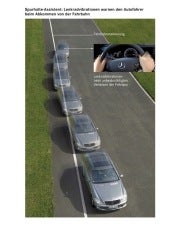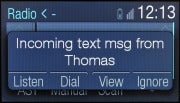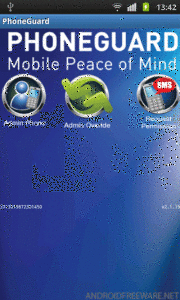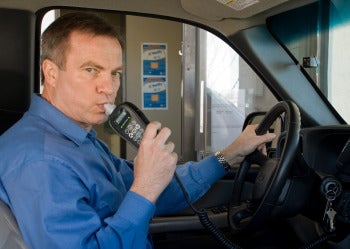Driving may be the most hazardous thing we do every day. Combine the activity's inherent dangerousness with error-prone human drivers who are increasingly distracted by things like smartphones, and it's no surprise that the crash statistics keep going up.
But automotive safety and convenience technology is advancing by leaps and bounds. The latest crop of smart features can correct veering steering, sense and alert a drowsy driver, and even wrest the driving from human control altogether. In addition, several fantastic apps promise to make our time behind the wheel much easier and safer.
But with all this new tech looking over our shoulder, is driving still fun? Is it the free-wheeling, self-determined, all-American high-speed kick that it used to be?
Between the White Lines
 Normally, the person driving the car is responsible for keeping it between the white lines on the roadway. But today's passive and active lane-assist technology can do that job for you.The passive systems feature a camera to monitor the road's lines, a computer to analyze the images, and a combination of audio information, visual data, and steering wheel vibrations to warn the driver when the vehicle starts drifting. Active lane-assist systems take it to the next level, using automatic braking to slow you down or steering torque to point you in the right direction. Some vehicles use just one type of system; high-end models may use both passive and active systems.
Normally, the person driving the car is responsible for keeping it between the white lines on the roadway. But today's passive and active lane-assist technology can do that job for you.The passive systems feature a camera to monitor the road's lines, a computer to analyze the images, and a combination of audio information, visual data, and steering wheel vibrations to warn the driver when the vehicle starts drifting. Active lane-assist systems take it to the next level, using automatic braking to slow you down or steering torque to point you in the right direction. Some vehicles use just one type of system; high-end models may use both passive and active systems.
Digital Nagging for Drowsy Driving
 Though common sense tells you not to drive when you're tired, plenty of groggy drivers venture out onto America's thoroughfares anyway. Mercedes-Benz's Attention Assist system combats drowsiness and distraction by warning the driver when it detects abnormal steering.
Though common sense tells you not to drive when you're tired, plenty of groggy drivers venture out onto America's thoroughfares anyway. Mercedes-Benz's Attention Assist system combats drowsiness and distraction by warning the driver when it detects abnormal steering.
Using a steering sensor and special software, Attention Assist measures 70-plus parameters of driving behavior during the first few minutes of operation, from which it establishes a unique driver profile. It then refers to this profile at speeds between 50 and 112 mph to identify a drowsy driver's erratic steering correction. When the driver starts to exhibit certain behaviors associated with drowsiness, an audible warning sounds, and a visual warning illuminates.
Keep Those Thumbs on the Wheel
Driving While Texting (DWT?) has caused thousands of deaths on America's highways. But a wave of new technologies may help us stop the carnage.

The 2010-up Ford Sync's Audible Text Messaging feature offers hands-free text reading and replying. The driver's phone syncs via Bluetooth, and alerts the driver when new texts arrive. Sync will read texts out loud through the vehicle's speakers, and the driver can send preset or customized responses without taking a finger off of the steering wheel. At this writing, however, Audible Text Messaging is compatible with only a handful of phones, so you might be better off downloading a freestanding voice recognition app from the App Store or from Google Play.
Put the Smartphone Down
 Whether you're texting, emailing, or surfing the Web behind the wheel, distracted driving increases your chances of having an accident. And if your sexy smartphone is simply too tempting to leave alone, apps such as PhoneGuard will gladly disable it for you.
Whether you're texting, emailing, or surfing the Web behind the wheel, distracted driving increases your chances of having an accident. And if your sexy smartphone is simply too tempting to leave alone, apps such as PhoneGuard will gladly disable it for you.
PhoneGuard uses GPS tracking to monitor your vehicle's speed. Once you reach 10 mph, PhoneGuard locks your phone's keyboard and suspends the phone's text, email, and Web functions. The app responds to incoming texts via Text Block with Auto Reply. The PhoneGuard Premium upgrade, which starts at $20 a year, adds many other features.
The regular PhoneGuard app is free and available through Google Play for Android, through App World for BlackBerry, and through the App Store for iPhone.
Booze Breath in the Car
An ignition interlock device prevents an alcohol-impaired person from adding to the United States' annual toll of 10,000-plus drunk-driving fatalities.
 Ignition interlock installations such as Smart Start's SSI-20/20 may be attached to an offender's car following a DWI conviction and subsequent court order. Such systems connect to the on-board computer system via a wire through the car's ignition and require the driver to pass a breath-analysis test before the vehicle will operate.
Ignition interlock installations such as Smart Start's SSI-20/20 may be attached to an offender's car following a DWI conviction and subsequent court order. Such systems connect to the on-board computer system via a wire through the car's ignition and require the driver to pass a breath-analysis test before the vehicle will operate.
With the ignition turned on, the unit initializes. The test taker then blows into the mouthpiece. Inside the unit, an alcohol-specific fuel cell sensor and a breath sampling system analyze the alcohol level in the subject's breath. If it falls below a predetermined allowable limit, the display will show 'PASS' and the vehicle can be started. If the person's level is close to the limit, 'WARN' will appear but the vehicle will still start. But if 'FAIL', 'VIOLATION', or 'ABORT' appear, the vehicle will remain disabled until the driver passes a follow-up test.
Source: http://feeds.pcworld.com/click.phdo?i=4ece7ec155fcbed014e8aa943cd05da8
cheap bose headphones bose sounddock ii bose laptop speakers bose sound bar bose acoustimass
No comments:
Post a Comment